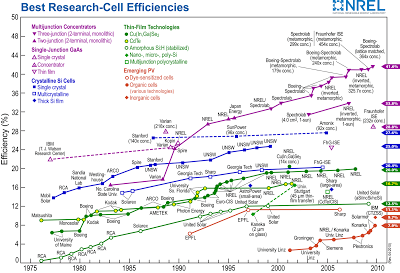By James Van Howe
This post originally appeared on Jim’s CLEO Blog and is reproduced with permission from the author.
This summer seems to be marked by a frenzy of solar energy initiatives and development. The Business News section in the May issue of Nature Photonics reported on four recent major investments in solar technology manufacturing: JA Solar of Shanghai plans to build a 3 GW capacity plant in Hefei, China for the manufacturing of monocrystalline silicon solar cells. Investors have pledged $2.05 billion over the next four years, and production is slated to begin in 2012. Polysilicon Technology Company, a joint venture between Mutajadedah Energy of Saudi Arabia, and KCC Corporation of Seoul will build a $1.5 billion facility to produce solar-grade polysilicon in Jubail, Saudi Arabia by 2017. The Indian government is discussing a joint venture with nanotech company, Rusanano, of Moscow to obtain a consistent supply of silicon for Indian photovoltaic manufacturers with hopes of obtaining 2,000 tons of silicon ingots for solar cell production. And SoloPower of San Jose was guaranteed $197 million from the U.S. Department of Energy (DOE) to build a plant in Oregon for the manufacturing of flexible copper-indium-gallium diselenide (CIGS) for light-weight solar panels.
The DOE made even bigger news for solar energy investment, however, at the end of June when it promised $4.5 billion for the construction of three different California photovoltaic power plants: Antelope Valley Solar Ranch 1, the Desert Sunlight Project, and the Topaz Solar Project. Arizona-based company First Solar, Inc will sponsor all three projects, constructing each solar array with cadmium telluride (CdTe), thin-film photovoltaic modules. Together, the new power plants will provide 1.33 GW (powering the equivalent 275,000 U.S. homes) and offset the generation of 1.8 megatons of carbon dioxide. As described by Alexis Madrigal, author of “Powering the Dream: The History and Promise of Green Technology,” (Da Capo Press, 2011), in a June 17, interview on NPR’s Science Friday, the Mojave Desert solar plants will prove to be particularly effective when compared to other green initiatives. One reason for their effectiveness is their location- the solar plants will be simultaneously near large population centers, L.A. and Las Vegas, with ideal conditions for sunshine- the desert. This is in contrast to wind energy where ideal locations for wind farms often correspond to areas with low population densities (like the plains of North Dakota) and so power distribution becomes an issue. Additionally, the sunlight in the desert suits itself to matching peak output of the solar grid with peak usage- as everyone cranks up the air conditioning at the hottest time of the day, the PV modules are cranking out the most amps.
 Time-line of photovoltaic efficiencies for various cell types; from the National Renewable Energy Lab
Time-line of photovoltaic efficiencies for various cell types; from the National Renewable Energy Lab
The choice of thin-film CdTe for the solar cells is once again due to balancing cost and efficiency. First Solar claims that its CdTe modules have the smallest carbon footprint (this includes fabrication and recycling of the module over its lifetime) compared to any photovoltaic on the market, as well as the fastest energy payback time (EPBT). They also note that the high temperature coefficient of CdTe allows their modules to perform better than silicon at higher temperatures, which will obviously be crucial given the heat conditions of the Mojave.
Other summer solar news include McGraw-Hill’s June 13, announcement to build the world’s largest private solar plant at its East Windsor, New Jersey campus. Though New Jersey is not as sunny as the Mojave Desert, the plant is slated to generate an impressive14 MW.
A detailed solar map was released by the City University of New York on June 16, which shows the solar energy production potential of New York City’s rooftops. The New York Times reported that the solar map, made by making LIDAR sweeps the previous year, shows that two-thirds of the New York’s rooftops have great potential for solar harvesting. If these rooftops were covered with solar panels, the city could use them to meet half of its electrical power consumption needs, even at peak use.
NYC roofs were not the only ones in the solar lime-light recently. Google announced on June 14, a partnership with SolarCity in which they will provide a $280 million fund to help finance SolarCity’s solar panel leasing program for rooftops across the U.S. …For the full original post, click here.
Posted: 14 July 2011 by
James Van Howe
| with 0 comments